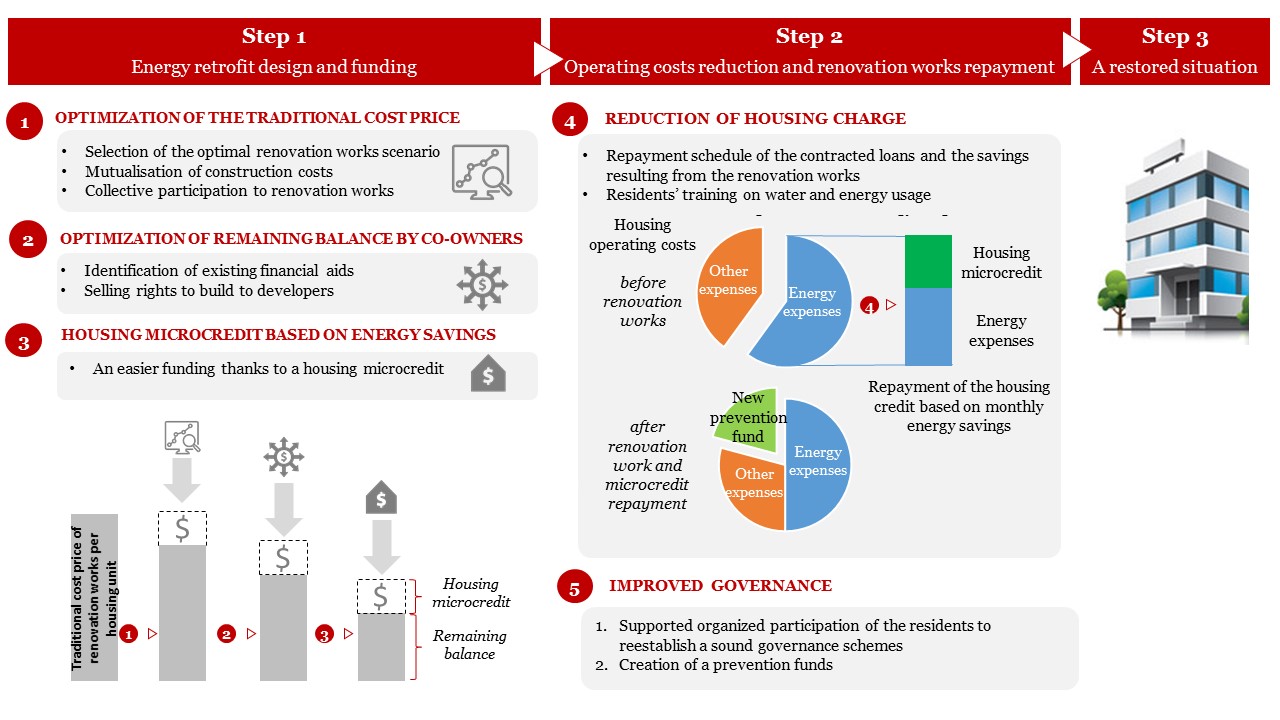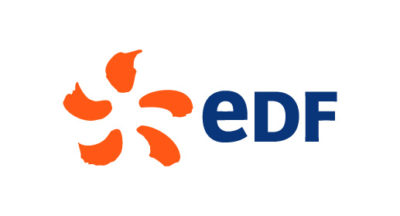
In short
The challenge
In France, an estimated 15% of condominiums are said to be very fragile. This amounts to 100,000 condominiums, or more than 1 million housing units[1]. The dilapidation of condominiums is due to management difficulties which result in high operating expenses, uncontrolled unpaid rental charges, discouragement of co-owners, and shortcomings in routine maintenance. Public authorities have programmed large improvement operations to deal with the problem. But these programmed operations are very costly, on the one hand, and they lack effectiveness, on the other hand. They can only freeze the dilapidation process and fail to stamp it out, because they do not allow for ambitious energy retrofits.
[1] Study ANAH / CGDD on the condominiums having fragility issues (December 2012)
What we offer
Please contact Hélène Tabuteau for more information.

Our partners
Read more
The challenge of dilapidated condos in France
The national agency providing housing improvement grants (« Agence Nationale d’Amélioration de l’Habitat », or « ANAH ») estimates that 15% of French condominiums are very fragile. This amounts to 100,000 condominiums, or more than one million housing units. In addition to this, the ANAH estimates that 5 to 15% of the remaining condos are on the verge of a similar decline.
The causes of condo dilapidation are well-known and are all related to management difficulties which result in :
- Expensive operating expenses
- Unpaid rent charges that tend to increase and become out of control
- Ineffective management, discouragement of co-owners and shorcomings in routine maintenance, ie. factors that tend to worsen the technical dilapidation of the building
This vicious circle is worsened by the fact that the most solvent co-owners will tend to leave the condo and will be replaced by low-income co-owners, which will in turn accelerate the previous phenomenon.
The shortcomings of public policies
Faced with the severity of the problem, public authorities have come-up with means and solutions that are unfortunately not up to the task :
- they have engaged in expensive improvement operations[2], with subsidies reaching sometimes 90 to 95% of the total cost of the operation, and are unable to handle a large number of housing units[3].
- they can only stop the dilapidation process temporarily because they do not address the causal roots of the problem which are the high level of rent charges and the governance failures[4].
Public authorities have tried to find new solutions. These are twofold :
- preventive actions : they have tried to set-up observation and prevention measures, they have implemented a register co-ownership associations (as a consequence of the ALUR law). They have also built a contingency fund in order to organize the upcoming construction works within the building (also a consequence of the ALUR law);
- global actions : public authorities have refocused on the structural causes of the problem (instead of only focusing on the built environment). They have implemented social diagnosis tools, and tried to remobilize co-owners.
Condo renovation projects are long and complex processes. They are often mismanaged. The problem is that condo renovation projects spread over 5 to 10 years in average, and involve a large number of stakeholders. This can jeopardise the overall success of the operation. It is absolutely necessary to reduce the length of these projects.
Furthermore, most of these projects only have a very small impact on energy costs. Yet cutting on such costs is essential, because energy cost savings are very aim justifying the cost of the operation. Reliability of estimations of the reduction in energy performance has to be insured through simulations. These simulations have to take into account the consumption habits of the residents.
Finally, the definition of a financing plan for any large project usually occurs at the end. We realized that the project design methods had to be renewed in order to provide co-owners with upfront, transparent information about the cost the project.
[2] From 2006 to 2010, ANAH gave over €471M of subsidies for delapidated condo rehabilitation. 52% of the total amount are dedicated to the co-ownership association, the other 48% depicts the individual subsidies. See Braye Report. [3] Only 1,3% of the very delapidated condo have been registered in the French Govenement operational measure between 2001 and 2011 (Forum of the private housing policies, « Workshop condo diagnostic », May 2013). [4] Among the condo which benefit from a rescue operation, 40% of the condo built before 1959, 55% of the condo built between 1960 and 1974 and 60% of the condo built after 1975 had renovation work of a total amount equivalent to less than 5 000€ per housing. This amount is not engouh to have impact on energy consumption.
The principles underlying our aproach to the problem
The Action Tank has been working since 2013 on a business model which would enable energy retrofits and the reestablishment of sound governance schemes within condos. We target a broad range of condos, as we intervene both in condos which are already dilapidated, complementing existing public policies, but also in fragile condos which are on the verge of dilapidation.
Please contact Hélène Tabuteau for more information.
Please contact Hélène Tabuteau for more information.











